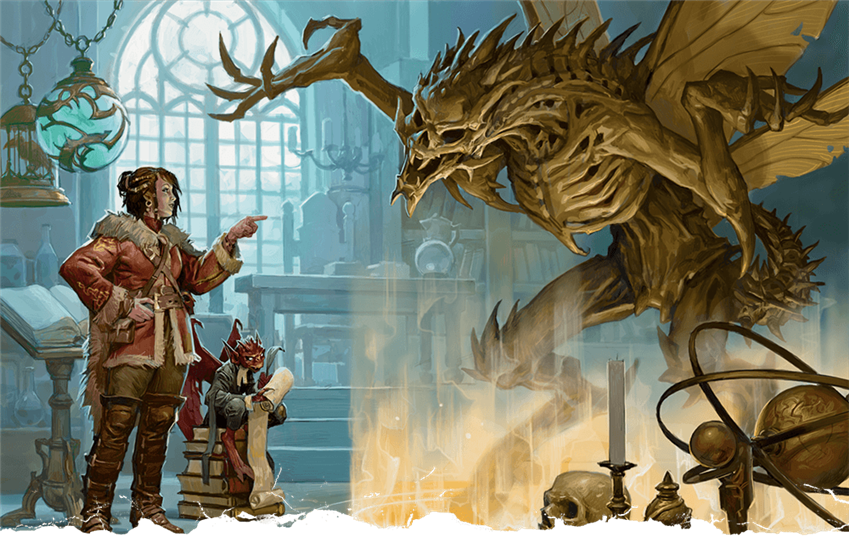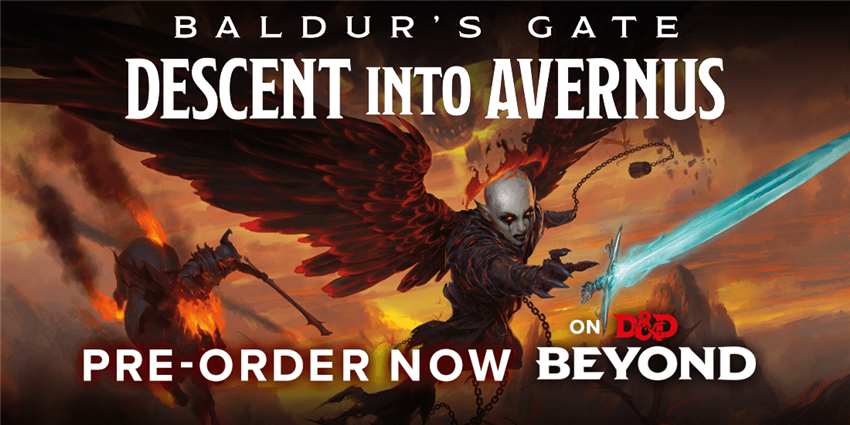Devils look at mortals as sheep, just as demons do, except devils see themselves not as wolves but as shepherds. Shepherds fleece sheep by the season and slaughter them as needed. A shepherd likely kills the wolves that threaten its sheep. But then again, shepherds always expect to lose a few sheep.
If you were a sheep, would you trust your shepherd?
—Mordenkainen, Mordenkainen’s Tome of Foes
 Violence is rarely a devil’s first thought when facing a mortal being. Even the mightiest pit fiend, whose skin is tough like steel, whose fangs drip venom, and who can hurl fireballs with a wave of its fingers, does not immediately think to crush a mortal under its heel at first glance. Though a demon might long constantly for bloodshed and death, devils are manipulators at heart. Some more martial devils, like the merregons that make up the backbone of the Nine Hell’s armies, have no interest in forging pacts, but would still defer to the orders of their commanding officer before killing a mortal on sight.
Violence is rarely a devil’s first thought when facing a mortal being. Even the mightiest pit fiend, whose skin is tough like steel, whose fangs drip venom, and who can hurl fireballs with a wave of its fingers, does not immediately think to crush a mortal under its heel at first glance. Though a demon might long constantly for bloodshed and death, devils are manipulators at heart. Some more martial devils, like the merregons that make up the backbone of the Nine Hell’s armies, have no interest in forging pacts, but would still defer to the orders of their commanding officer before killing a mortal on sight.
The Blood War rages eternal, and as Avernus, first layer of the Nine Hells, is the endless conflict’s front lines, the devils of Avernus are in constant need of reinforcements. For, as any diabolist would be quick to remind you, a devil killed outside of its home plane is only temporarily banished to the Nine Hells, but a devil killed within the Hells themselves is destroyed for good. And as countless devils die each day in Avernus, countless more souls are needed to fuel the Blood War. Mordenkainen, arbiter of balance within the multiverse, would be quick to say that the damnation of countless souls is a good thing—as an Infernal defeat in the Blood War would spell a quick and messy doom for all life among the cosmos as the demons, no longer held in check by devils, would consume all around them.
Mordenkainen may be right, but you certainly don’t want to be the chump who has their soul damned to the Nine Hells. And how do you wind up as a Hells-damned soul? The best way is to make a deal with a devil. Some deals are made en masse, without the informed consent of all participants—some are made one-on-one, when a mortal desires incredible power—and if you’re a soul with countless mighty deeds etched upon it, like a mighty hero or terrible villain, then devils seeking glory and praise from their infernal superiors will be all but tripping over themselves to make deals with you.
These are devils: 50% part lawyer from Hell, 50% part snake oil salesman, 100% willing to end your miserable existence if you renege on your side of the deal. Let’s learn how to play a devil.
A Game of Souls
All archdevils have a quota of souls that they are compelled to deliver to Asmodeus, Lord of the Nine Hells, in a certain period. Think of the Nine Hells as a pyramid scheme, in which Asmodeus reaps all the benefits of ruling the Hells, while his archdevils beneath him use a near-infinite hierarchy of greater and lesser devils to reap enough souls to meet the quotas set for them by Asmodeus. Lesser and greater devils (ranging from the most pathetic imp to the most superior pit fiend) can only enter contracts with mortals on behalf of their archdevil master. For instance, a mortal who calls upon Mephistopheles (such as Faust in the Goethe play of the same name) might deal with the archdevil Mephistopheles himself if the mortal is sufficiently interesting, but odds are their deal will be arbitrated by a lesser or greater devil in Mephistopheles’s service.
This is not to say that devils in service to an archdevil gather souls simply out of a sense of devotion. Far from it. Even the most pathetic of devils is constantly scheming, gazing longingly at the infernal pinnacle of its hierarchy and seeking a way out of its wretched lowliness. Each soul it condemns to the Nine Hells is one step towards its goal.
Each time a devil signs a contract that pledges a mortal’s soul to the Nine Hells, that devil receives credit for the achievement. A stronger soul, such as a mighty warrior who leaves mortality behind to become an ice devil, is worth more than a simple peasant likely to be consigned to existence as a lemure.
—Chapter 1: The Blood War, Mordenkainen’s Tome of Foes
Most devils earn their souls by making deals and creating infernal contracts, in which the signer’s soul is used as collateral. Some contracts offer power in exchange for a mortal’s soul. Some contracts essentially hold the signer’s soul in escrow, keeping the soul if the signer violates the terms of the deal, or returning it undamaged if the signer upholds the terms. Exceptionally intelligent devils such as narzugons, ice devils, and amnizus intentionally place deceptive or outright predatory clauses within their deals in an attempt to sucker mortals who fail to read the fine print.
If you want to play a devil like a master legalistic trickster, first consider the Intelligence of the devil. If its Intelligence score is only 10, it probably won’t be drafting the most conniving contracts (unless it has a specific reason to be highly proficient in that skill). Devils with an Intelligence score of 16 or higher are able to create tricky “gotcha” clauses in their contracts, while archdevils and devils with an Intelligence of 20 or higher make nigh-impenetrable contracts filled with archaic language with obscure double-meanings.
If a devil isn’t able to snare a mortal’s soul in one fell swoop, Baldur’s Gate: Descent into Avernus also reveals a roundabout way a persistent devil can nickel-and-dime you into damnation. “[Otherwise, a] devil tries to take it one piece at a time by encouraging the mortal to commit evil acts and thereby condemning the mortal’s soul to the Nine Hells [after their death].” In D&D, all souls travel to a plane that suits their alignment in the afterlife, and a devil that manages to guide a mortal down a path that changes their alignment to Lawful Evil ultimately wins in the end. This passage from Baldur’s Gate: Descent into Avernus comes from its appendix A: Diabolical Deals, which is invaluable for any Dungeon Master who wants to snare their players with infernal contracts.

Occultism and You!
There’s another way for devils to win the mortal souls they so crave, and many see it as the most efficient way to success: serving a cult. Many devil cults enter into contracts en masse, with potentially hundreds of mortals signing away their souls—or at least committing soul-damningly evil acts, as described above. Oftentimes, a devil cult is in service to an archdevil, and a lesser or greater devil interfaces directly with the cult’s leader, and the cult’s leader dictates the fates of all their followers, and all of their sacrifices as well. The cult of Asmodeus in Waterdeep: Dragon Heist is a prime example of this. In rarer cases, a cult may be formed to worship a greater devil of uncommon power, such as one that was deposed from archdevilhood at Asmodeus’s whim. The archdevil Bel, former ruler of Avernus, still has worshipers on the Material Plane, and may grant them power directly.
Rarer still, lesser or greater devils have been known to escape from the Nine Hells and exist in secret on the Material Plane. These escapes only occur when the devil is directly summoned, such as with a gate spell. A devil in service of Zariel, for instance, might be summoned to fight alongside a militant cult—and might survive when the cult is routed in battle by paladins of Tyr. This devil could go on to pose as a humanoid and start a cult of its own, thus making a deal directly with mortals who might be unaware that they are dealing directly with a devil.
Most archdevils can assume a humanoid shape, but there are some other devils that can could lead a cult directly with creative use of their abilities, such as:
- Imps. An imp can appear as a bat, raven, or spider. Perhaps an imp could form a cult surrounding a talking raven that pretends to be a herald of the Raven Queen?
- Orthons. Orthons are hulking trackers that can turn invisible at will. Though it can’t assume a humanoid guise, it could use Wizard of Oz-style theatrics to pass itself as a demigod to be feared and obeyed.
- Erinyes. An erinyes has a naturally humanoid appearance, and could pass for a female humanoid if it hid its wings. It could also pose as an avariel (a winged elf), or even as a celestial.

Legion of Fear and Hellfire
Despite their diplomatic prowess, devils are also fearsome warriors. The legions of the Nine Hells are finite, but massive. And while, unlike demons, devils rarely attack mortals indiscriminately, a devil with cause to kill is a terrifying creature indeed. Devils often attack in cleanly regimented armies, with legions of faceless merregons marching in lockstep, shaking the earth beneath their boots, all commanded by a lesser devil that serves as their fiendish taskmaster. Such a legion may be preceded by a swarm of lemures, serving as worthless cannon fodder to spoil enemy charges and disrupt their advance.
Facing a devil with intent to kill should strike fear into the hearts of both players and their characters. Here are ways you can use the truly fearsome might of a legion of devils to intimidate your players.
Orderly Tactics. When a devil enters combat, they always attack the foes their commander orders them to attack. Devils often prove challenging opponents because their commander can order them to gang up on single targets, or intelligently command even the most foolish of legionnaires to attack in strategic ways. However, this comes at a cost. A devil commander can only issue new orders on its turn, causing these regimented tactics to react sluggishly to a chaotic battlefield.
Leverage over Slaughter. Devils prefer sparing mortals to killing them, as a mortal at their mercy is more likely to accede to a contract’s foul terms under duress. Though a quick death is far preferable to damning your soul to an eternity of war on the Lower Planes, most mortals’ basic survival instinct always supersedes logic. Thus, when a devil reduces a humanoid to 0 hit points, it always chooses to knock them out instead of killing them, unless their orders or specific circumstances demand otherwise.
Surrounded by Cannon Fodder. Whenever the characters face a devil in combat, that devil is always joined by a group of lemures. The number of lemures increases proportionally to its commander’s challenge rating; 1d4 per level of challenge. For instance, a spined devil would be accompanied by 5 (2d4) lemures, and a mighty pit fiend would be joined by a whopping 50 (20d4) lemures. These pathetic devils could be used as combatants, but you would be better off having them serve as an environmental effect. A space occupied by four or more lemures could count as difficult terrain and deals 1d4 bludgeoning damage to any hostile creature that walks through it.
Alternatively, you could alter the swarm of poisonous snakes creature to be a swarm of lemures by giving it a lemure’s Damage Resistances, Damage Immunities, and Condition Immunities and removing the snakes’ poison. Each swarm of lemures is composed of 8 lemures. Note that turning the otherwise nebulous swarms of lemures into a distinct creature makes them significantly more deadly than before. Consider this swarm’s strength when building your encounter, in this case. Finally, a group of lemures is only kept in check by their commander. If their commander falls in battle, the pathetic, mindless devils are too senseless to continue fighting, and they start wandering aimlessly.
A Glimpse of Hell. When a devil is killed outside of the Nine Hells, consider adding a minor cosmetic effect to its death. Upon the devil’s death, its body vanishes in a flash of fiery light, but within that light, the devil’s killer can see a vision of horrific torment. This vision is specific to the level of the Nine Hells that the devil’s archdevil master rules over. A devil that serves Zariel may grant the character a brief glimpse of the banks of the River Styx as the Blood War rages across its banks; while a devil that serves Mammon may grant a vision of a vast field of gold coins, as tormented devils count and calculate the incalculable wealth of their avaricious master.
How have you played devils in your game? Do you have any stories of truly terrifying infernal encounters?

You can pit your characters against the forces of the Nine Hells and the Abyss in Baldur’s Gate: Descent into Avernus, available for preorder on the D&D Beyond Marketplace!
 James Haeck is the lead writer for D&D Beyond, the co-author of Waterdeep: Dragon Heist and the Critical Role Tal'Dorei Campaign Setting, a member of the Guild Adepts, and a freelance writer for Wizards of the Coast, the D&D Adventurers League, and other RPG companies. He lives in Seattle, Washington with his partner Hannah and their animal companions Mei and Marzipan. You can find him wasting time on Twitter at @jamesjhaeck.
James Haeck is the lead writer for D&D Beyond, the co-author of Waterdeep: Dragon Heist and the Critical Role Tal'Dorei Campaign Setting, a member of the Guild Adepts, and a freelance writer for Wizards of the Coast, the D&D Adventurers League, and other RPG companies. He lives in Seattle, Washington with his partner Hannah and their animal companions Mei and Marzipan. You can find him wasting time on Twitter at @jamesjhaeck.








-
View User Profile
-
Send Message
Posted Sep 18, 2019Did you mean lemures? :D Great article, by the way! I love practical advice like this.
Also, the link to the "How to Play a Demon like an Engine of Destruction" article seems to be broken (403 error).
-
View User Profile
-
Send Message
Posted Sep 18, 2019It looks like these articles were published in a different order than I originally intended!
-
View User Profile
-
Send Message
Posted Sep 18, 2019In my long-running campaign I had an overarching plot pitting devils against the undead in the background (an undead god was letting people out of their infernal bargains by granting them undeath, no death, soul stays out of the Hells, keep the power) The PCs were a LG Paladin, NG Ranger, and NG Druid. While creeping through an underground ruin deep beneath a corrupt old city, they encountered a group of mid-level devils, too many to fight, so they listened and overheard them plotting.
When the lead devil said "The paladin and his allies are here in the city. Do all you that can to aid their mission from the shadows, but do not let yourselves be discovered. They are not to be harmed or obstructed. Once they have dealt with the <undeath cult> have them rewarded and send them on their way quickly." The look on our Paladin's face when he heard that the devils were conspiring to HELP him was priceless.
-
View User Profile
-
Send Message
Posted Sep 18, 2019Also your math is wrong!
Pretty sure that would make out at 80 :D
(otherwise great work!)
-
View User Profile
-
Send Message
Posted Sep 18, 2019How's this for evil contracts?: I read a comic where a druid entered a contract to let devils bind evil souls to the druid for the necessary power to save the druid's family. They implied that the souls can affect the personality of the person (as if it was some kind of warning). The druid waived it off to save the family... and then went on to commit atrocities. Turns out that the souls had absolutely no bearing on the druid's personality at all and the devils never actually said that would happen. "A good way to get a decent person to do something horrible is to convince them that they're not responsible for their actions." OOTS #640
-
View User Profile
-
Send Message
Posted Sep 18, 2019I love the idea of Orcus, Acerak, or Vecna denying souls to hell through undeath!
-
View User Profile
-
Send Message
Posted Sep 18, 2019I got the new adventure on launch day, and boy will this help! You're the best James!
-
View User Profile
-
Send Message
Posted Sep 19, 2019Nice.
-
View User Profile
-
Send Message
Posted Sep 19, 2019Orcus even has motivation to do it.
-
View User Profile
-
Send Message
Posted Sep 19, 2019I'm currently DM'ing a campaign that heavily involves devils and demons working under a single banner to take the material plane by storm. The party has already (accidentally) released a cambion into a medium-sized city and then like any other great and intelligent group of adventurers, they just went away leaving the little devil bastard to do whatever he wants. Safe to say the city may look slightly different whenever they choose to return to it.
-
View User Profile
-
Send Message
Posted Sep 19, 2019I'd imagine so. One of my DM's did something similar. There was a 'patron' who we'd occasionally receive info or items from, throughout the campaign. And our patron would only rarely ask us for something. Usually a harmless-seeming favor, like take this thing to this person/place or make sure to kill this thing in this place. And each time, something positive would happen to us. Well, at about 13th level, our patron wanted to meet with us. Turns out it was a devil, (Don't remember what type, may have been a homebrewed; but it was definitely powerful) As we were about to battle it, the DM (whose wife was a lawyer) whipped out a 15 page document, placed it on the table, and told us that this was the contract we'd slowly been building with the devil, which; in no fewer than 17 separate entries, outlined exactly what would befall us if we took any combative action against it. And then it proceeded to tell us, "Now, we can keep doing business, destroying common enemies, with you having a chance to earn your souls back as stated in section IV, Page II, Entry XVI; or I can collect them right now, which I would hate to do, and ruin such a lovely partnership and your lives."
So, in the end, our group of Good characters ended up agreeing to continue to accept aid from the Devil, with our Cleric of Good reconciling it with "The gods give us all tools to work to our advantage, this is simply a more dangerous tool."
-
View User Profile
-
Send Message
Posted Sep 19, 2019A read of C.S. Lewis' The Screwtape Letters would also help greatly here.
-
View User Profile
-
Send Message
Posted Sep 19, 2019Actually, Vaarsuvius is a wizard. Otherwise, though, it's a pretty good example.
-
View User Profile
-
Send Message
Posted Sep 20, 2019Currently Running a homebrew campain, the party is workign for Iggwilv to kill Graz'zt, this will help me A Lot,
my party currently working with Iggwilv's butler, name Chauser, he is a devil, but the party is not 100% sure what, he is Polite and very smart
this will help his character immensly
-
View User Profile
-
Send Message
Posted Sep 20, 2019Awesome article! ....Now I want to get Descent into Avernus
-
View User Profile
-
Send Message
Posted Sep 20, 2019Interesting article. Very useful for me in the future. I'm a bit curious about the semantics of en-masse damnation though. Specifically having your soul sold by someone else, such as by a parent or through ritual sacrifice.
Like the Cassalanters in Dragon Heist. That either sell their children or sacrifice ninety-nine bystanders, none whom even know what's going on.
-
View User Profile
-
Send Message
Posted Sep 20, 2019You might want to edit your comment and specify the spoiler refers to the Dragon Heist campaign. Otherwise, we curious creatures just click on Spoiler, not knowing it's spoiling what exactly. :P
-
View User Profile
-
Send Message
Posted Sep 20, 2019I knew this was be from OotS (although you got that character's class wrong (maybe on purpose?)). Great example.
-
View User Profile
-
Send Message
Posted Sep 20, 2019and the max calculation is incorrect...
-
View User Profile
-
Send Message
Posted Sep 22, 2019A website I read long ago that introduced me to the whole Planescape/Great Wheel thing had an interesting take on Devils and the Lawful Evil alignment in general. Contrary to the popular conception, Lawful Evil does not use the letter of the law to defeat the spirit of the law. I think it's more interesting to have a Devil who plays honestly-but-cynically to what the character needs and wants. No futzing around with double meanings; indeed, diabolical contracts are so complex because they want to be able to point to the text and say that they gave you exactly what you asked for. It's mortal impatience that causes us to gloss over those key definitions and think we're agreeing to something other than what we're actually agreeing to.
The key isn't to make the mortals think we're getting something other than what we're getting, it's to get us to decide that no, we really don't care about our souls, the well-being of those around us, the long-term consequences, or whatever the risk or cost is: we want, we tell ourselves we need the thing so badly that it's worth it. A super-sword that will help us slay the Dark Lord before she lays waste to the entire continent and kills millions is worth installing a few corrupt leaders and advisers in the courts and churches of the realm, right? They can't possibly do as much damage as she can, can they? I mean, it would be unconscionable to surrender a real advantage in the fight against such an overwhelming, dire, and immediate threat, wouldn't it?
If your Devils are doing their job right, someone should be able to honestly make the argument that taking the deal really is the right thing to do.
"I forgot you could tempt me with things I want."